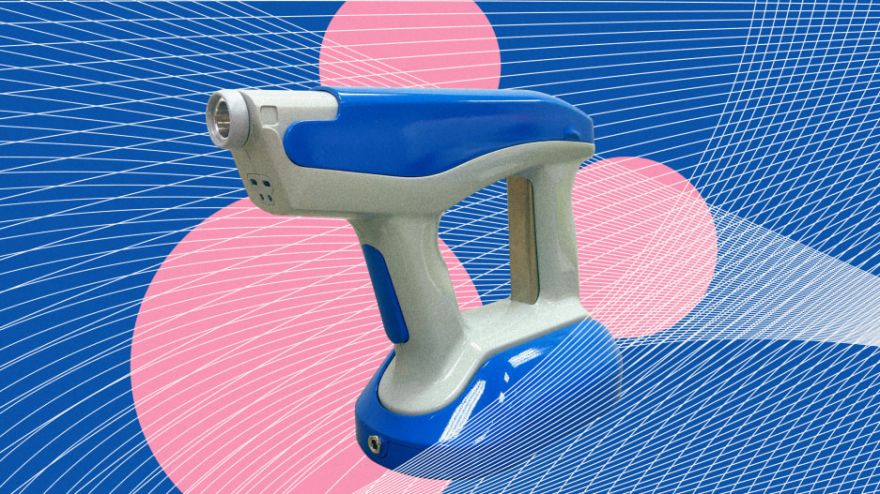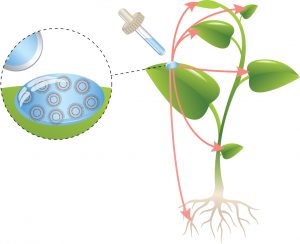
Where I see a ‘ray’ gun, Rina Raphael, author of a July 6, 2019 article for Fast tCompany, sees a water pistol (Note: Links have been removed),
Imagine if bandaging looked a little more like, well, a water gun?
Israeli startup Nanomedic Technologies Ltd., a subsidiary of medical device company Nicast, has invented a new mechanical contraption to treat burns, wounds, and surgical injuries by mimicking human tissue. Shaped like a children’s toy, the lightweight SpinCare emits a proprietary nanofiber “second skin” that completely covers the area that needs to heal.
All one needs to do is aim, squeeze the two triggers, and fire off an electrospun polymer material that attaches to the skin.
The Nanomedic spray method avoids any need to come into direct contact with the wound. In that sense, it completely sidesteps painful routine bandage dressings. The transient skin then fully develops into a secure physical barrier with tough adherence. Once new skin is regenerated, usually between two to three weeks (depending on the individual’s heal time), the layer naturally peels off.
“You don’t replace it,” explains Nanomedic CEO Dr. Chen Barak. “You put it only once—on the day of application—and it remains there until it feels the new layer of skin healed.”
…
“It’s the same model as an espresso machine,” says Barak.
The SpinCare holds single-use ampoules containing Nanomedic’s polymer formulation. Once the capsule is firmly in place, one activates the device roughly eight inches towards the wound. Pressing the trigger activates the electron-spinning process, which sprays a web-like a layer of nano fibers directly on the wound.
The solution adjusts to the morphology of the wound, thereby creating a transient skin layer that imitates the skin structure’s human tissue. It’s a transparent, protective film that then allows the patient and doctor to monitor progress. Once the wound has healed and developed a new layer of skin, the SpinCare “bandage” falls off on its own.
The product is already being tested in hospitals. In the coming year, following FDA clearance, Nanomedic plans to expand to emergency rooms, ambulances, military use, and disaster relief response like fire truck companies. The global wound healing market is expected to hit $35 billion by 2025, according to a report by Transparency Market Research.
…
Nanomedic joins other researchers attempting to reimagine the wound healing process. Engineers at the University of Wisconsin-Madison, for example, created a new kind of protective bandage that sends a mild electrical stimulation, thereby “dramatically” reducing the time deep surgical wounds take to heal.
As for the the playful (yet functional) design, it resembles other medical tools utilizing the point-and-shoot feature. Researchers at the Technion-Israel Institute of Technology and Boston Children’s Hospital recently revealed a “hot-glue gun” that melds torn human tissues together. The medical glue is meant to replace painful and often scarring stitches and staples.
Down the line, Nanomedic plans to enter the in-home care market, where it believes it can better assist caretakers for treatment of chronic wounds, such as pressure ulcers. The chronic wounds segment is projected to hold the dominant share in the wound healing market due to aging populations.
…
But a bigger opportunity lies in the multiple uses the SpinCare can ultimately provide. It is, in essence, a platform technology that could benefit multiple categories, not just medical wound care. Currently, the SpinCare’s capsules do not contain any active ingredients.
Nanomedic is already researching how to add different additives, such as antibacterial compliments, collagen, silicone, cannabinoids—and, eventually, stem cells and cellular treatments.
Such advancements would propel the device to new markets, like plastic surgery, aesthetics, and dermatology. The latter, for example, spans “burns” caused by deep, cosmetic laser peels.
“Because it is a solution, we can combine additives inside,” explains Katz. “By that, we are transforming the transient skin into a drug delivery system and slow release system.”
Nanomedic is still at the premarket phase, [emphasis mine] having concluded one clinical trial related to the treatment of split graft donor site wounds and currently engaged in two ongoing burn studies. Barak anticipates FDA approval will take between nine to 12 months, during which the company will focus on building manufacturing lines and preparing for a European launch in early 2020.
According to the startup’s estimates, the product’s final price (not yet determined) will be far more affordable than traditional dressings. Nanomedic has raised $7 million in funding to date, including a grant by the EU’s Horizon 2020 SME Instrument program.
Barak believes Nanocare [sic] brings a highly cost-effective alternative to the healthcare system, but more than anything, she’s proud that SpinCare, above all else, mitigates patient pain and hassle. Some users, the company reports, are able to return to work and physical activity right away.
…
The Nanomedic website can be found here. The company has also produced a video featuring SpinCare,
There’s a bit more about the technology (I’m especially interested in the electrospinning) on Nanomedic’s Technology webpage,
Electrospinning technology allows the development of a wide range of products and devices, with tailored composition, geometry and morphology.
Almost any natural or synthetic polymer can be electrospun to create a nanofibrous mat. The intrinsic structure of the electrospun products, which mimics the natural extra cellular matrix (ECM), encourages quick and efficient tissue integration and minimizes medical complications.
Raphael’s article and the Nanomedic website offer more detail to what you can see in the excerpts provided here. If you have the time, I recommend checking out both.
